
The London and North Western Railway was a British railway company between 1846 and 1922. In the late 19th century, the L&NWR was the largest joint stock company in the United Kingdom.
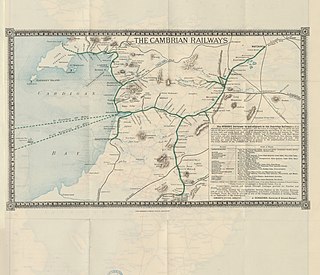
The Cambrian Railways owned 230 miles (370 km) of track over a large area of mid Wales. The system was an amalgamation of a number of railways that were incorporated in 1864, 1865 and 1904. The Cambrian connected with two larger railways with connections to the northwest of England via the London and North Western Railway, and the Great Western Railway for connections between London and Wales. The Cambrian Railways amalgamated with the Great Western Railway on 1 January 1922 as a result of the Railways Act 1921. The name is continued today in the route known as the Cambrian Line.

Princess Royal was a British merchant ship and blockade runner that became a cruiser in the Union Navy during the American Civil War and later returned to civilian service.
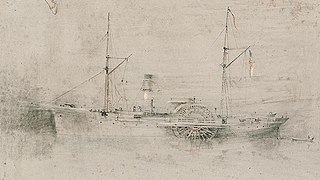
USSKeystone State was a wooden sidewheel steamer that served in the Union Navy during the American Civil War. She was a fast ship for her day and was used effectively to blockade Confederate ports on the Atlantic coast. She participated in the capture or destruction of 17 blockade runners. In addition to her military service, Keystone State had a lengthy commercial career before the war. Renamed San Francisco, she also sailed commercially after the war. The ship was built in 1853 and scrapped in 1874.

CSS Sumter, converted from the 1859-built merchant steamer Habana, was the first steam cruiser of the Confederate States Navy during the American Civil War. She operated as a commerce raider in the Caribbean and in the Atlantic Ocean against Union merchant shipping between July and December 1861, taking eighteen prizes, but was trapped in Gibraltar by Union Navy warships. Decommissioned, she was sold in 1862 to the British office of a Confederate merchant and renamed Gibraltar, successfully running the Union blockade in 1863 and surviving the war.
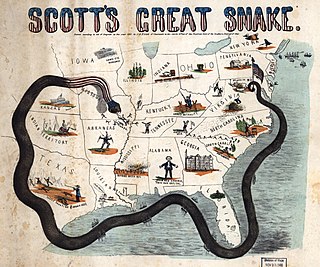
The Union blockade in the American Civil War was a naval strategy by the United States to prevent the Confederacy from trading.

USS Santiago de Cuba was a side-wheel steamship acquired by the Union Navy during the first year of the American Civil War. She was outfitted as a gunboat with powerful 20-pounder rifled guns and 32-pounder cannon and was assigned to the Union blockade of the Confederate States of America. She was notably successful in this role, capturing several blockade runners. Her last major action of the war was the assault on Fort Fisher, during which seven of her crew won the Medal of Honor.

The Pacific Mail Steamship Company was founded April 18, 1848, as a joint stock company under the laws of the State of New York by a group of New York City merchants. Incorporators included William H. Aspinwall, Edwin Bartlett, Henry Chauncey, Mr. Alsop, G.G. Howland and S.S. Howland.

The first USS Gettysburg was a steamer in the Union Navy. The ship was built in Glasgow, Scotland in 1858, named Douglas, and operated for the Isle of Man Steam Packet Company between Liverpool, United Kingdom and Douglas on the Isle of Man until November 1862. She was then sold to the Confederacy, renamed Margaret and Jessie, and operated as a blockade runner until her capture by the Union on 5 November 1863. The ship was renamed Gettysburg, and commissioned into the Union Navy on 2 May 1864.
The Chester and Holyhead Railway was an early railway company conceived to improve transmission of Government dispatches between London and Ireland, as well as ordinary railway objectives. Its construction was hugely expensive, chiefly due to the cost of building the Britannia Tubular Bridge over the Menai Strait. The company had relied on Government support in facilitating the ferry service, and this proved to be uncertain. The company opened its main line throughout in 1850. It relied on the co-operation of other railways to reach London, and in 1859 it was absorbed by the London and North Western Railway.

The USS Cherokee was a 606-ton screw steam gunboat in the US Navy during the American Civil War ship. The ship later served in the Chilean Navy.
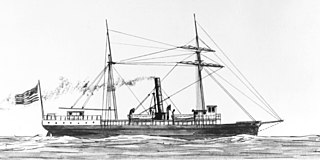
The passenger-cargo steamer Fah-Kee was launched in 1862 at Greenpoint, Brooklyn and operated on the United States coast until purchased in July 1863 by the Union Navy during the American Civil War. The Navy used USS Fahkee as a collier and freight supply ship assigned to assist Union Navy ships patrolling Confederate waterways.

The first USS Wanderer was a high-speed schooner originally built for pleasure. It was used in 1858 to illegally import slaves from Africa. It was seized for service with the United States Navy during the American Civil War. In U.S. Navy service from 1861 to 1865, and under outright U.S. Navy ownership from 1863 to 1865, she was used by the Union Navy as a gunboat, as a tender, and as a hospital ship. She was decommissioned, put into merchant use, and lost off Cuba in 1871.
The third USS Union was a heavy (1,114-ton) steamer with a powerful 12-inch rifled gun purchased by the United States Navy during the American Civil War.

The North Wales Mineral Railway was formed to carry coal and ironstone from the mineral-bearing area around Wrexham to the River Dee wharves. It was extended to run from Shrewsbury and formed part of a main line trunk route, under the title The Shrewsbury and Chester Railway. It opened in 1846 from Chester to Ruabon, and in 1848 from Ruabon to Shrewsbury. It later merged with the Great Western Railway.
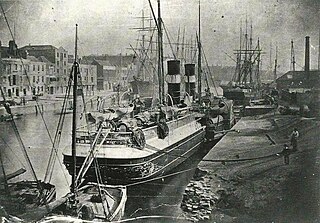
PS Alfred was a passenger paddle steamer that was launched in 1863. She was renamed Old Dominion in 1864, Sheffield in 1865 and Prince Arthur in 1867. The London and North Western Railway (LNWR) and the Lancashire and Yorkshire Railway (L&YR) acquired her in 1871 and operated her until 1877.
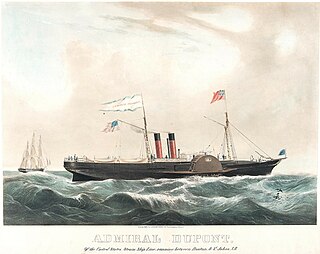
PS Anglia was a paddle steamer passenger vessel operated by the Chester and Holyhead Railway from 1847 to 1859 and the London and North Western Railway from 1859 to 1861.
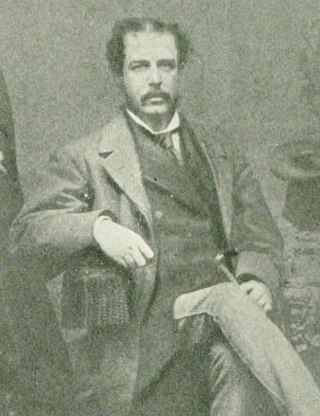
Francis William Jones Hurst, a native of the British West Indies, was a major figure in the cross-Atlantic shipping business in the 19th century. During the American Civil War, he captained ships that ran the Union blockade of Confederate ports. From the War's end to his death, he was the New York-based manager for the National Steam-Ship Company. The National Line brought goods and thousands of emigrants from ports in the British Isles to New York.

Throughout the American Civil War, blockade runners were seagoing steam ships that were used to get through the Union blockade that extended some 3,500 miles (5,600 km) along the Atlantic and Gulf of Mexico coastlines and the lower Mississippi River. The Confederate states were largely without industrial capability and could not provide the quantity of arms and other supplies needed to fight against the industrial North. To meet this need blockade runners were built in Scotland and England and were used to import the guns, ordnance and other supplies that the Confederacy desperately needed, in exchange for cotton that the British textile industry needed greatly. To penetrate the blockade, these relatively lightweight shallow draft ships, mostly built in British shipyards and specially designed for speed, but not suited for transporting large quantities of cotton, had to cruise undetected, usually at night, through the Union blockade. The typical blockade runners were privately owned vessels often operating with a letter of marque issued by the Confederate States of America. If spotted, the blockade runners would attempt to outmaneuver or simply outrun any Union ships on blockade patrol, often successfully.
Commodore Jonathan Young was an officer in the United States Navy. He participated in anti-piracy actions and the African Slave Trade Patrol, fought in the Mexican War, Puget Sound War, and American Civil War, and served briefly as commander of the Asiatic Squadron.
















